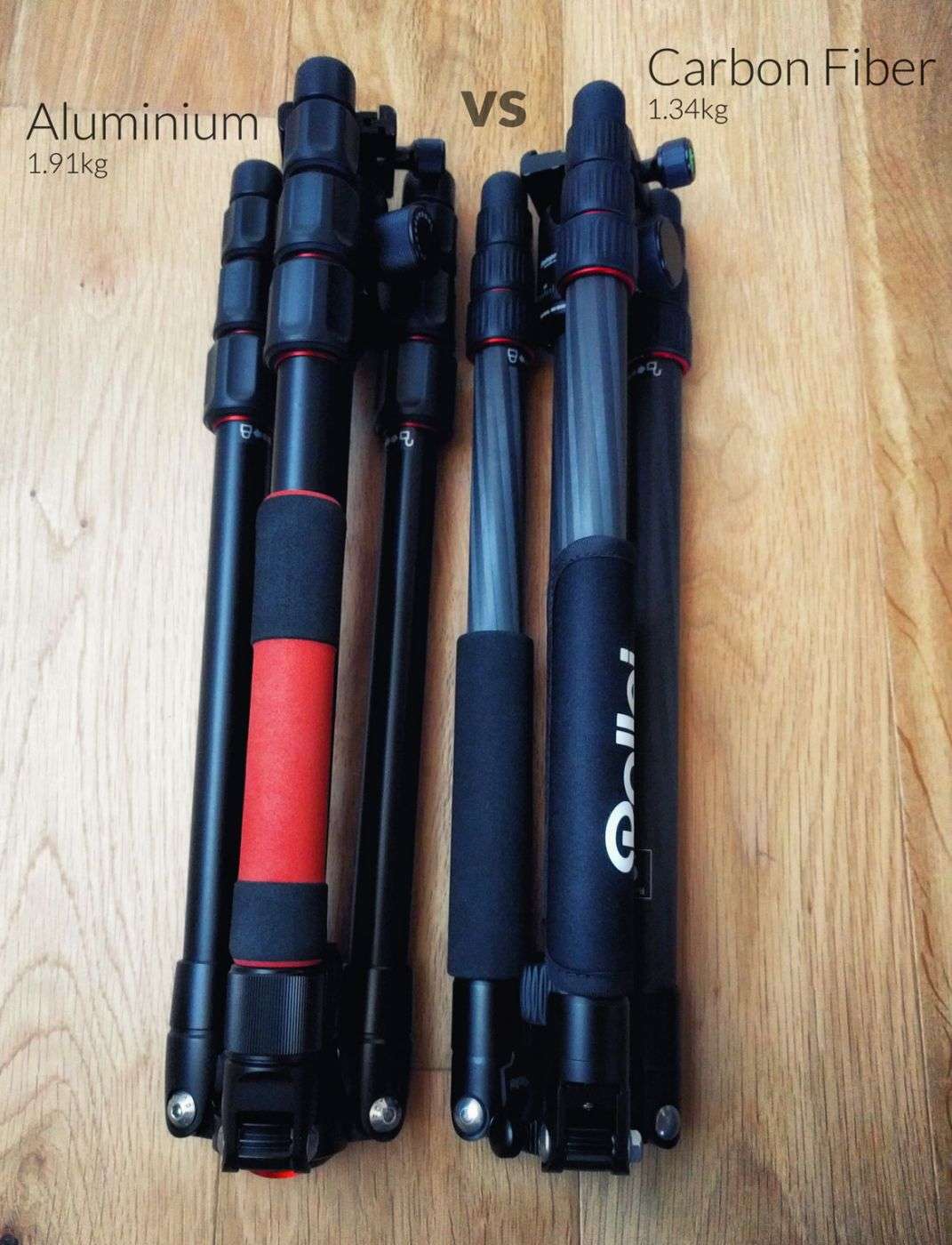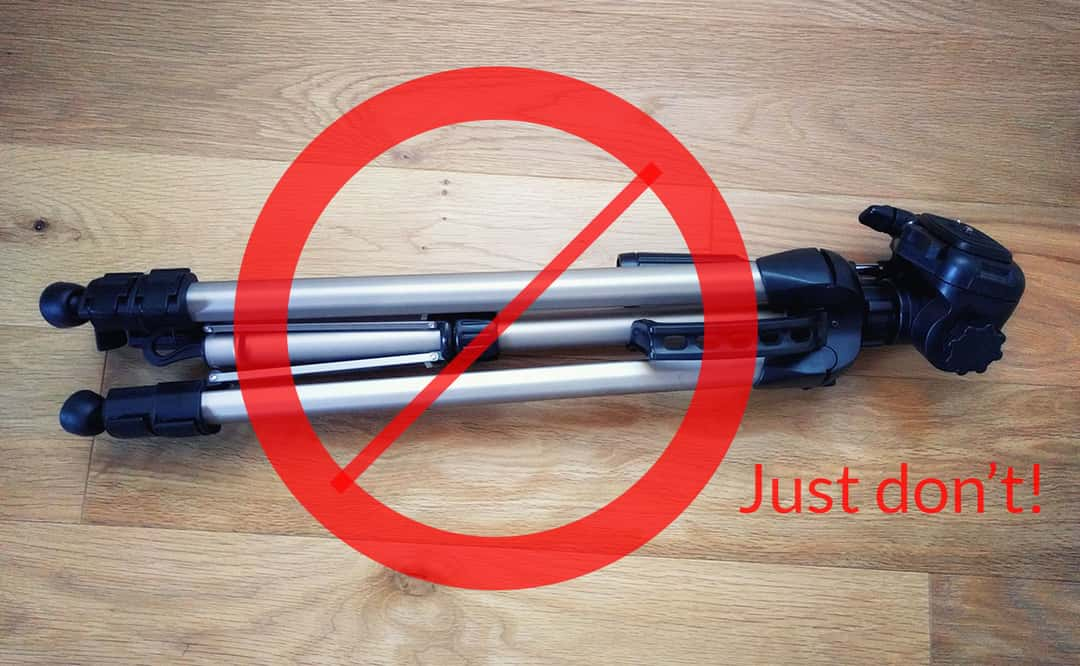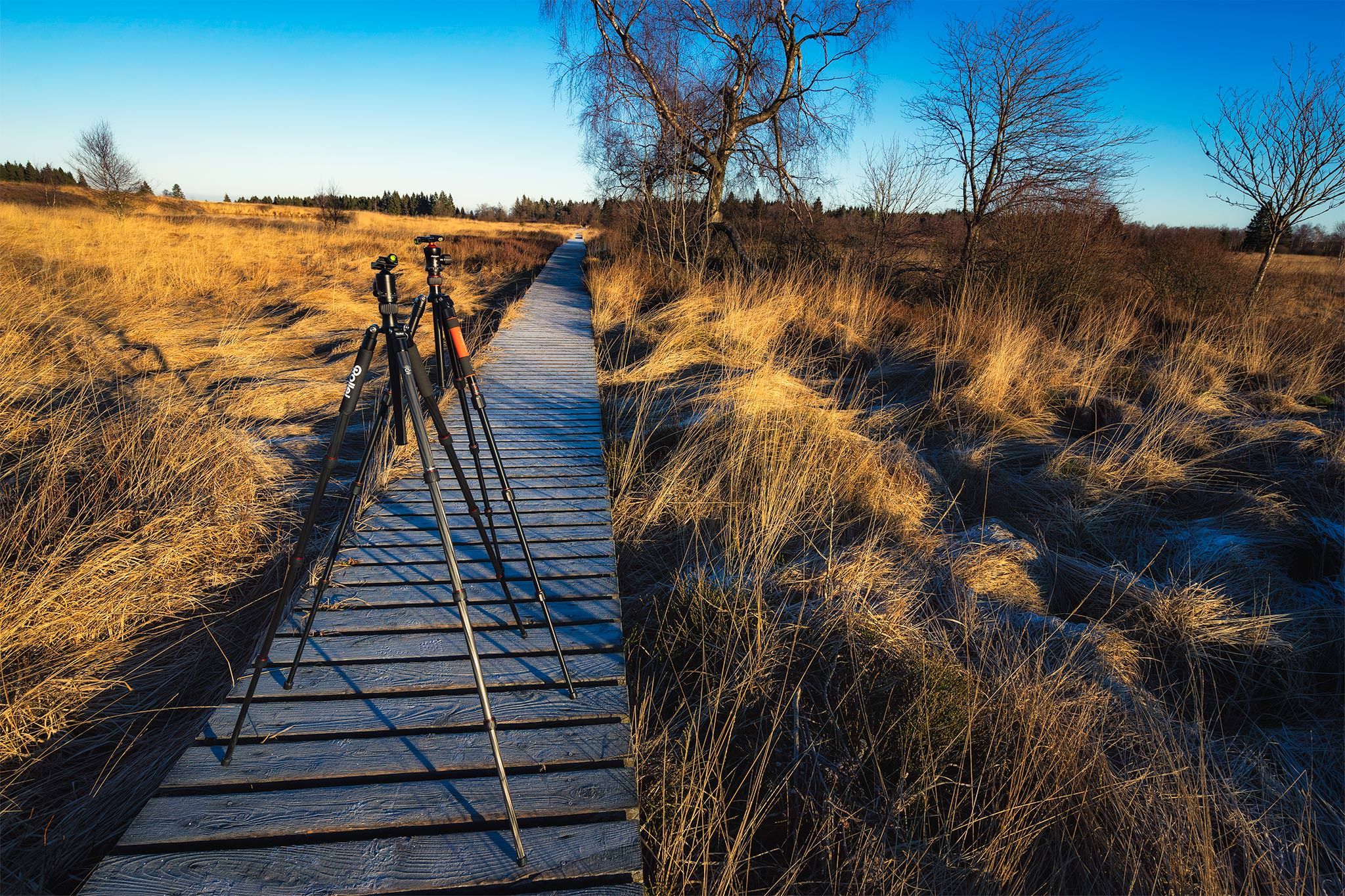Nearly every photographer needs a tripod, whether the material is carbon or aluminum. Since this is usually a very long-lasting type of equipment it’s even more important to choose the right one for you, which therefore starts with the decision about the material.
The easy answer to this question about the right material could be, that a beginner just should get the cheaper aluminum version, and an advanced photographer should grab the more expensive carbon fiber tripod. But in my opinion, it’s not that obvious, because both have their pros and cons or are just different, not even better or worse.
To have a good way of comparing these two kinds of tripods, I purchased the exact same type made of aluminum I have already used for years in carbon fiber:
Rollei C-5i II Aluminium
Rollei C-5i Carbon
Both came with a predefined ball head (which is of course Arca Swiss compatible) and are nearly the same sized with a max height of around 160cm and a collapsed height of around 44cm. The aluminum version has a payload of 10kg, the carbon fiber one can still handle 8kg.
Weight
One of the most important parts besides stability is obviously the weight because a tripod is only good if you have it with you. This is a very good reason to make sure that you have to carry as little weight as possible with you because otherwise, you will always think about leaving it at home. But this factor is still different for everybody because it very much depends on the type of photography you are doing. A studio portrait photographer may not care so much about a heavier tripod, but a travel photographer who is on his feet all day long will benefit from less stuff on his shoulders without a doubt. Therefore it depends very much on how often and how long you are underway to the places you are shooting at. In Iceland for example it wasn’t as important as I initially thought to have a very lightweight solution, because you will probably drive very big parts of your trip anyway and it's very much dependent on if you are hiking a lot or not. In some cases, it may be even better to have a heavier tripod due to the stormy weather and powerful rivers because more weight also results in more stability.
Aluminium: 1.91kg
Carbon: 1.34kg

If weight is important for you, then Carbon is definitely the better choice.
My advice
Nearly 600g doesn’t sound that much, but it’s a huge difference if you have to carry this all day long on your shoulders. About 1 year ago I switched my camera to a lighter mirrorless one, which is saving me around 500g and this alone was such a great change to me. Sometimes I was walking around cities like New York for 10 days or more in a row, which meant carrying all your stuff for 14 hours a day, resulting in shoulder pain after a few days. I even started to leave my tripod at home for some days, but these are always the situations you will need it, and like I initially said your equipment will be only helpful if you have it with you.
If you are walking a lot with your equipment, you should definitely get a carbon fiber tripod right away.
Material properties
When it comes to the material itself, there are 3 key properties you should consider for your decision.
1. Corrosion
Carbon is very weather-resistant and even resists corrosion when used in salt water for example. Aluminum tripods are usually protected by an additional layer, but scratches or other damages may result in corroding material when used under humid circumstances.
2. Vibration Reduction / Vibration Absorption
This is something that every seller will tell you about carbon fiber tripods and why you should buy one, but for me personally that’s only a nice side effect and kind of an elusive advantage. The reason behind that is, that there are so many other good and much more important ways to improve the stability of your tripod at no charge: 1. use a remote control to prevent shakes to your camera that are caused by yourself, 2. focus and photograph by using the display of your camera, because this makes sure that the mirror is already flipped up and won’t shake your camera when you start to expose your image (this only applies to DSLRs of course) and 3. attach something heavy to the hook of your tripod (most of the modern tripods have one and you should definitely pay attention to this detail during your purchase decision) to improve the sturdiness even more. Just keep in mind that there are a lot of situations where vibrations come from a source that is preventable in other ways than putting more money into your equipment. This is also true for taking photos in a river, where a heavier tripod maybe even better than one that absorbs vibrations better.
3. Temperatures
Something a lot of people don’t know is, that a damaged carbon fiber tripod will behave differently than an aluminum one. The big distinction between both materials is that aluminum will bend first and eventually break. Carbon though is not ductile and will shatter at its deflection limit. Therefore little damage might affect an aluminum version, but the carbon might only bounce back without a scratch. Carbon is vulnerable to extremely cold weather though, which means that if you are going to photograph a whole night of the Northern Lights under very cold conditions you should make sure that you don’t strike it with anything hard because it tends to break faster under those conditions. It’s probably not something that applies to most of the tripod owners, but it’s good to keep something like that in mind.
On the other hand, you might even prefer carbon under those cold conditions because it does not chill your hands nearly as much as aluminum does. However good tripods usually have a rubber casing, so this shouldn’t affect your decision on a large scale.
My advice
As you see there is no real winner in this section when it comes to the advantages of the materials. They are just different and behave distinct in a variety of situations. I would probably give the carbon tripod a little edge here, but it definitely comes down to what type of photography you are doing and what’s important to you.
Pricing
When it comes to the price, the span of different tripods is pretty huge, because it’s not only about the material but also about the available sizes, the quality, the intended purpose, and of course about the different brands. For this reason, I am reducing the variety to the 2 tripods I am owning and comparing in this article. There are still plenty of other great tripods available, but it just wouldn't help you to list them all here because this article is more about the differences between the materials.
Aluminium: 138,99€ on Amazon DE
Carbon: 249,99€ on Amazon DE
As you can see the range between those 2 prices isn’t that big and comes down to only 111€. Usually, carbon tripods are much pricier though, because the target group seems to be the advanced photographers, so those will also often come with better workmanship. For the 2 tripods from Rollei, the difference isn’t that big, but the carbon version definitely feels a little bit more valuable, but it’s also the newer one of the company's product line.
Important side note: Carbon is not more expensive as a material and therefore automatically the better choice. Carbon though needs some finishing steps that need to be done by hand, which obviously results in higher prices. Aluminium on the other hand can be fully produced by machines.
My advice
You probably won’t buy a new tripod every year, because compared with the camera industry there is not so much changing, which makes it even more important to buy a good and sturdy one instead of having to buy a few ones until you finally realize that you should have bought the more expensive one in the first place. Seen from this perspective it’s often even cheaper to get the right one straightaway. A valid objection though is if you are just starting your photography career and you are not sure yet that you will stick with this hobby. In this case, you might think of starting with an aluminum version, because these are definitely cheaper than the carbon fiber tripods.
Final words
As you saw there are quite a lot of differences between carbon fiber and aluminium tripods. If I was you I would prefer the following one based on your situation:
- Carbon Fiber: If you are traveling a lot especially if you are hiking or if you are photographing cities, which means that you will have to walk for quite some time, the weight of your tripod is just too crucial. In this case, I would definitely go with this material. You can still save some money by getting a tripod like the Rollei C-5i Carbon, which is a very keen price for this material, and a ballhead is already included.
- Aluminium: If you are just starting your photography, if you don't need a tripod too often or if you prefer studio photography, this material is definitely a great choice to work with. Especially if you need a very sturdy and solid one for a great price, you might give the preference to aluminum.
In the end, you will be definitely fine with both as long as you consider the following additional tips.
Additional tips
No matter which brand or type of material you prefer, please make sure that you won’t buy the cheapest tripod you can find on the market. I saw so many people during my travels, having camera gear for a few thousand bucks attached to a 20€ tripod. When your expensive gear gets damaged because you saved some money on your tripod you didn’t save anything.

Just don't!
The same applies to the quality overall, because a tripod definitely isn’t a tripod. I tried a lot of them, also started very early with a cheap one and it was a real pain to adjust the camera orientation. It literally destroyed me so many opportunities and images because I had a bad tripod or because I didn’t take it with me because it was to heavy to carry it every day with me. Anything you do in life also has something called opportunity costs, which means that if you experience the most amazing sunset in your life in New York for example and you are not able to capture it, you won’t get this chance as easy again as eating a bagel for breakfast the next morning. It would cost you a huge amount of time and money to come back to this place over and over again, so always keep this in mind and don’t just save a few bucks when the trip itself costs thousands of Euros/Dollars/…

These Gorillapods seem to be a good way in between because they are very light, small, and still can carry a lot of weight. There are situations when they are good, but there are even more situations when you will curse them, for example when there is a handrail you can attach it to but all the tourists are shaking it for no reason and you won't get a single sharp photo. I paid over 100€ for mine and I can't recommend it, but it's definitely a reasonable option for some situations.
70€ is what I pay each time I fill up my car's tank and every time I am at a spot where my tripod makes it harder to get the photo I want is wasted money you could have saved on staying home, enjoying the evening with other activities. Please remember those things when buying a tripod and get the one that suits you best. I definitely can recommend the Rollei c5i series I have been using now for quite a while and they are not paying me to say this. It’s just a great way to get started with very good quality and without paying 1000€ or more for your tripod. There is always something that’s better, the question that remains though is if you need this "something".
Thank you for reading this article about Carbon Fiber vs. Aluminium tripods. I talked so much and now I would love to hear your opinion about this topic! Which kind of tripod are you using? Let me know in the comments below.





Comments (18)